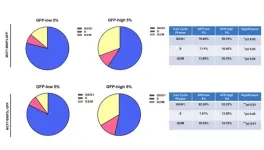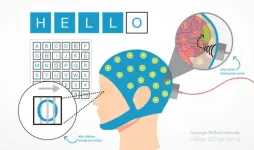(Press-News.org) Forecasters can use images in social media to better communicate weather related hazards of hurricanes, according to a pair of new studies.
Scientists at the U.S. National Science Foundation National Center for Atmospheric Research (NSF NCAR) analyzed 2017 Twitter (now X) data related to two hurricanes – Harvey and Irma. The researchers found that forecast information communicated in the early stages of storm development, when the threat posed by a hurricane is uncertain, sets the stage for how people react to subsequent warning messages.
The research team also identified ways authoritative sources, such as the National Weather Service, broadcast meteorologists, and emergency managers, can better engage at-risk community members.
“When we began this research, a lot of work had been done analyzing Twitter data in the post-disaster space, and we were interested in how people were responding to weather forecast information in earlier stages, especially as predictions change,” said NSF NCAR scientist Rebecca Morss, lead author of the Hurricane Harvey paper. “Twitter provided a natural laboratory for us to look at what communications people are responding to and what information they are sharing. This kind of research can help the meteorological community learn what are the most important things to communicate and how to improve that messaging.”
The research was supported by NSF NCAR and funded in part by NOAA and a grant from NSF.
Risk Information Ecosystem
Harvey and Irma both occurred in 2017, but the two storms behaved very differently from one another. Harvey was an atypical hurricane that rapidly intensified and then lingered along the Texas coast for a few days, leading to devastating flooding in the Houston region. Whereas Irma was forecast well in advance of making landfall and followed a more typical movement pattern over land, leading to significant risks from strong winds and storm surge. Combined, the two storms provided complementary data about the different types of hurricane risks that need to be communicated amid varying levels of uncertainty.
Twitter offered the NSF NCAR researchers a detailed log of how people were sharing and reacting to information in real time. The research team developed a dataset of tweets that was relevant to each hurricane and focused on tweets posted by authoritative sources.
To evaluate how the tweets communicated information about the storms to those in harm’s way, the researchers categorized tweets based on the type of visuals used and looked for patterns in what image types were retweeted and interacted with the most. Additionally, the researchers examined the content of replies to forecast and warning tweets to explore how people in at-risk areas make sense of and respond to a hurricane’s evolving threat.
“In early stages of the threat, we could see a really clear cadence that every six hours there would be an uptick in Twitter conversation about the hurricanes,” said NSF NCAR scientist Robert Prestley, lead author of the Hurricane Irma paper. “This was driven by the National Hurricane Center putting out updated forecast information. That information would then be redistributed by broadcast meteorologists, emergency managers, news media, and weather enthusiasts, and the conversation would grow from there. It really highlighted the key role of the National Weather Service in leading this communication.”
Morss and Prestley also observed that the role of the national and local National Weather Service (NWS) offices shifted over the course of a hurricane. As the storm developed, NWS centers such as the National Hurricane Center played the leading role in spreading information, but as the storms began to impact communities, local NWS offices took the lead in generating locally relevant forecast and warning content.
Viral Visuals
The research identified several types of images that were commonly used to convey information about the threat of a hurricane. Of these, the “cone of uncertainty” was the most retweeted graphic.
The cone of uncertainty shows the current location of a tropical storm as well as the probable track of the storm’s center with a cone shape around it that represents the uncertainty of the track based on historical errors. Previous research has shown that cone images have several limitations such as a lack of information about the risks to those outside of the cone, which can lead to people falsely believing areas outside of it are not at risk.
“There's a clear need for better uncertainty visualizations, especially in the forecast and warning period when people are looking for information, but there's not yet enough certainty to say specifically where or what the impacts will be,” Prestley said. “The cone is not necessarily equipped to do that. The question is how to maintain the visibility of an image people are accustomed to while more effectively communicating hurricane risks to different populations.”
The researchers also identified ways image content varied across the two hurricanes. For instance during Hurricane Harvey, tweets that included images highlighting heavy rain and flooding were highly retweeted. The high engagement with those tweets demonstrates the value of authoritative sources tweaking their communication to emphasize the different risks posed by individual storms.
The image type least interacted with was watch and warning imagery. These images include information about watches and warnings issued by NWS for hazards like flash floods, high winds, or tornadoes. Often these images are generated by automated programs and include identical or similarly formatted text and visualizations.
Many of these watches and warnings are issued for narrow geographic areas over short time-frames, which could explain why most of them have few retweets. Morss and Prestley recommend more research into how to improve communication of watch and warning information on social media, including how and when to use automated tweets to rapidly disseminate more user friendly information.
Although several things about Twitter have changed since the NSF NCAR research team conducted their studies, the research conducted by Morss, Prestley, and colleagues using the platform built a new understanding of how people respond to evolving information about natural disaster threats. Currently, the researchers are using additional research methods, including surveys before, during, and after weather events, to study the way people react to pending natural disasters. The Twitter studies helped shape the questions used in this ongoing research.
The knowledge gained can help professional weather communicators improve how they use social media networks as a vibrant resource for improving disaster communication.
About the articles:
Title: Information Dissemination, Diffusion, and Response during Hurricane Harvey: Analysis of Evolving Forecast and Warning Imagery Posted Online
Author: Rebecca E. Morss, Robert Prestley, Melissa Bica, and Julie L. Demuth
Journal: Natural Hazards Review
Title: Contextualizing Disaster Phases Using Social Media Data: Hurricane Risk Visualizations during the Forecast and Warning Phase of Hurricane Irma
Author: Robert Prestley and Rebecca E. Morss
Journal: Weather, Climate, and Society
END
Spinning up hurricane communications
Tweets analyzed by NSF NCAR scientists offer insight into effective hurricane risk messaging
2024-06-17
ELSE PRESS RELEASES FROM THIS DATE:
How the ketogenic diet improves healthspan and memory in aging mice
2024-06-17
The ketogenic diet has its fanatics and detractors among dieters, but either way, the diet has a scientifically documented impact on memory in mice. Whlie uncovering how the high fat, low carbohydrate diet boosts memory in older mice, Buck scientists and a team from the University of Chile identified a new molecular signaling pathway that improves synapse function and helps explain the diet’s benefit on brain health and aging. Published in the June 5, 2024 issue of Cell Reports Medicine, the findings provide new directions for targeting the memory effects on a molecular level, without requiring a ketogenic diet or even the byproducts of it.
“Our ...
Brazilian scientists develop functional bread to help prevent asthma
2024-06-17
Brazilian researchers have developed functional bread with the potential to prevent asthma, a respiratory disorder responsible for some 350,000 hospitalizations per year in the SUS (Sistema Único de Saúde), the nation’s public healthcare network.
The formulation, for which a patent application has been filed in Brazil (BR1020210266465), is described in an article published in the journal Current Developments in Nutrition. It contains Saccharomyces cerevisiae UFMG A-905, ...
Potential new treatment option for diabetic retinopathy
2024-06-17
Potential New Treatment Option for Diabetic Retinopathy
OU researcher developing potential new treatment for diabetic retinopathy that could address the problem much earlier.
OKLAHOMA CITY, OKLA. – Patients with diabetes face a host of potential health problems as they work to manage the chronic disease. Still, one concern that seems to weigh heavily is the risk of losing their sight through a condition known as diabetic retinopathy.
Researchers at the University of Oklahoma Health Sciences and Memorial Sloan Kettering (MSK) Cancer Center are studying a new, revolutionary treatment for diabetic retinopathy that could change the prognosis ...
Paternal use of metformin during sperm production not associated with major birth defects
2024-06-17
Embargoed for release until 5:00 p.m. ET on Monday 17 June 2024
Annals of Internal Medicine Tip Sheet
@Annalsofim
Below please find summaries of new articles that will be published in the next issue of Annals of Internal Medicine. The summaries are not intended to substitute for the full articles as a source of information. This information is under strict embargo and by taking it into possession, media representatives are committing to the terms of the embargo not ...
American diets have a long way to go to achieve health equity
2024-06-17
Poor diet continues to take a toll on American adults. It’s a major risk factor for obesity, type 2 diabetes, cardiovascular disease, and certain cancers, and more than one million Americans die every year from diet-related diseases, according to the Food and Drug Administration. Poor diet and food insecurity is also costly, attributing to an estimated $1.1 trillion in healthcare expenditures and lost productivity. These burdens also contribute to major health disparities by income, education, zip code, race, and ethnicity.
In a study from the Food is Medicine Institute at the Friedman School of Nutrition Science and Policy at Tufts University published today in ...
New ‘aging atlas’ provides a detailed map of how cells and tissues age
2024-06-17
A new aging atlas gives scientists an in-depth view of how individual cells and tissues in worms age and how different lifespan-extending strategies might stop the clock.
Aging impacts all the tissues in our body – from our muscles to our skin. Figuring out how individual tissues and cells age could help researchers better understand the aging process and aid in the development of anti-aging treatments.
Due to their short lifespans, simple body plans, and genetic similarity to humans, many researchers study aging in roundworms. To look at aging at the level of tissues and cells, a team of researchers from HHMI's Janelia ...
New technology allows researchers to precisely, flexibly modulate brain
2024-06-17
By Beth Miller
Human brain diseases, such as Parkinson’s disease, involve damage in more than one region of the brain, requiring technology that could precisely and flexibly address all affected regions simultaneously. Researchers at Washington University in St. Louis have developed a noninvasive technology combining a holographic acoustic device with genetic engineering that allows them to precisely target affected neurons in the brain, creating the potential to precisely modulate selected cell ...
Origins of cumulative culture in human evolution
2024-06-17
Each of us individually is the accumulated product of thousands of generations that have come before us in an unbroken line. Our culture and technology today are also the result of thousands of years of accumulated and remixed cultural knowledge.
But when did our earliest ancestors begin to make connections and start to build on the knowledge of others, setting us apart from other primates? Cumulative culture — the accumulation of technological modifications and improvements over generations — allowed humans to adapt to a diversity of environments and challenges. But, it is unclear when cumulative culture first developed during hominin evolution.
A study published ...
Mitophagy and cancer: BNIP3/BNIP3L’s role in stemness, ATP production, proliferation, and cell migration
2024-06-17
“[...] our current work has provided a novel strategy to enrich for a sub-population of cancer cells, with high basal levels of mitophagy.”
BUFFALO, NY- June 17, 2024 – A new research paper was published on the cover of Aging (listed by MEDLINE/PubMed as "Aging (Albany NY)" and "Aging-US" by Web of Science) Volume 16, Issue 11, entitled, “Mitophagy and cancer: role of BNIP3/BNIP3L as energetic drivers of stemness features, ATP production, proliferation, and cell migration.”
Mitophagy is a selective form of autophagy which permits ...
Breakthrough approach enables bidirectional BCI functionality
2024-06-17
Brain-computer interfaces or BCIs hold immense potential for individuals with a wide range of neurological conditions, but the road to implementation is long and nuanced for both the invasive and noninvasive versions of the technology. Bin He of Carnegie Mellon University is highly driven to improve noninvasive BCIs, and his lab uses an innovative electroencephalogram (EEG) wearable to push the boundaries of what’s possible. For the first time on record, the group successfully integrated a novel focused ultrasound stimulation to realize bidirectional BCI that both encodes and decodes brain waves using machine learning in a study with 25 human subjects. This work opens ...
LAST 30 PRESS RELEASES:
Golden Gate method enables rapid, fully-synthetic engineering of therapeutically relevant bacteriophages
Polar weather on Jupiter and Saturn hints at the planets’ interior details
Socio-environmental movements: key global guardians of biodiversity amid rising violence
Global warming and CO2 emissions 56 million years ago resulted in massive forest fires and soil erosion
Hidden order in quantum chaos: the pseudogap
Exploring why adapting to the environment is more difficult as people age
Society for Laboratory Automation and Screening welcomes new scientific director: Madeline M. Farley, Ph.D.
Austrian cow shows first case of flexible, multi-purpose tool use in cattle
Human nasal passages defend against the common cold and help determine how sick we get
Research alert: Spreading drug costs over the year may ease financial burden for Medicare cancer patients
Hospital partnership improves follow up scans, decreases long term risk after aortic repair
Layered hydrogen silicane for safe, lightweight, and energy-efficient hydrogen carrier
Observing positronium beam as a quantum matter wave for the first time
IEEE study investigates the effects of pointing error on quantum key distribution systems
Analyzing submerged fault structures to predict future earthquakes in Türkiye
Quantum ‘alchemy’ made feasible with excitons
‘Revoice’ device gives stroke patients their voice back
USF-led study: AI helps reveal global surge in floating algae
New method predicts asthma attacks up to five years in advance
Researchers publish first ever structural engineering manual for bamboo
National poll: Less than half of parents say swearing is never OK for kids
Decades of suffering: Long-term mental health outcomes of Kurdish chemical gas attacks
Interactional dynamics of self-assessment and advice in peer reflection on microteaching
When aging affects the young: Revealing the weight of caregiving on teenagers
Can Canada’s health systems handle increased demand during FIFA World Cup?
Autistic and non-autistic faces may “speak a different language” when expressing emotion
No clear evidence that cannabis-based medicines relieve chronic nerve pain
Pioneering second-order nonlinear vibrational nanoscopy for interfacial molecular systems beyond the diffraction limit
Bottleneck in hydrogen distribution jeopardises billions in clean energy
Lung cancer death rates among women in Europe are finally levelling off
[Press-News.org] Spinning up hurricane communicationsTweets analyzed by NSF NCAR scientists offer insight into effective hurricane risk messaging




